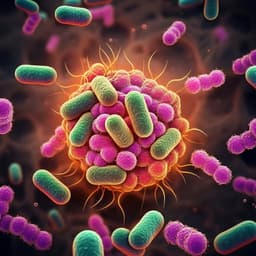
Economics
Glyphosate ban will have economic impacts on European agriculture but effects are heterogeneous and uncertain
R. Finger, N. Möhring, et al.
This research conducted by Robert Finger, Niklas Möhring, and Per Kudsk investigates the economic effects of a potential glyphosate ban in European agriculture, revealing significant variability in losses across different crop types and highlighting substantial gaps in knowledge regarding the implications for various farming systems across Europe.
~3 min • Beginner • English
Introduction
Efficient pest and weed management is crucial for food security, but reliance on pesticides has environmental and human health costs, motivating risk reduction policies. Glyphosate is the most widely used herbicide in Europe, applied across annual and perennial crops and for multiple purposes (weed control, cover crop and grassland termination, pre-emergence use, desiccation). Concerns about potential health and environmental effects have fueled debates on banning glyphosate; assessments by IARC (probable carcinogen) and subsequent EFSA/ECHA evaluations (not classifiable as carcinogen) have led to regulatory uncertainty and short renewals, as well as national restrictions. Decisions on approval are risk-based but also consider broader societal and economic factors. The study’s purpose is to provide an overview and synthesis of existing evidence on potential farm-level economic impacts of a glyphosate ban in European agriculture, given its extensive current use (about 30% of annual crop area and 50% of perennial tree crop area) and the expectation that bans could increase costs, reduce yields, and force system changes (e.g., tillage practices and rotations).
Literature Review
Background literature documents glyphosate’s widespread adoption in Europe (one third of herbicide use; global agricultural use ~746,580 t in 2014) and diverse applications, with no GM glyphosate-tolerant crops cultivated in Europe, leading to distinct use patterns. Prior research and reviews discuss potential human health and environmental effects and the dependence of impacts on alternative strategies (chemical vs non-chemical). The regulatory debate intensified after IARC’s 2015 classification, with subsequent EFSA/ECHA conclusions and EU-level renewals, alongside some Member States announcing bans or strong restrictions. Existing economic assessments have been heterogeneous in geography, crops, methods, and scope, with a bias toward certain countries (notably Germany and France) and major arable crops (wheat frequently studied). Perennial crops and uses like grassland and cover crop termination or desiccation are less frequently analyzed. Few studies explicitly evaluate implications for conservation agriculture and tillage systems, despite glyphosate’s enabling role in reduced- or no-till systems.
Methodology
The authors conducted a systematic literature review and evidence synthesis focused on European farm-level economic impacts of a glyphosate ban. Triangulation included: (1) database searches in Web of Science and Scopus with combinations of keywords ("glyphosate", "ban", "glyphosate ban", "costs", "losses", "economic impact", "profit"); (2) Google Scholar searches to capture grey literature and non-English sources; and (3) expert consultation via the ENDURE network across 21 European countries (responses from 12) to identify national reports and literature in multiple languages (English, German, French, Swedish, Danish). Inclusion criteria: European studies reporting economic implications of non-use or a ban of glyphosate at farm level (e.g., cost increases, profit reductions). Exclusions: non-European contexts, studies not reporting economic farm-level implications, and assessments focused on upstream/downstream industries or on environmental/health effects. A snowballing approach reviewed references and citing articles of shortlisted works. Where multiple versions existed, the most recent was used. For each study, the authors extracted: publication year, country/countries, crops/production systems, glyphosate applications considered, estimated economic impacts (converted to €/ha/year where possible), methodologies (e.g., surveys, expert interviews, partial budgeting, bio-economic models, econometrics), key assumptions (e.g., substitution strategies), peer-review status, and funding. Exchange rates as of May 2022 were used for currency conversion. Given heterogeneity and limited observations, a quantitative meta-analysis was not feasible; instead, a qualitative synthesis is provided.
Key Findings
- Nineteen studies (2010–2022) assess farm-level economic implications of a glyphosate ban in Europe; 10 are peer-reviewed and 9 grey literature. Coverage is biased toward certain countries (e.g., Germany, France; also UK, Spain, Italy, Sweden, Denmark, Austria, Switzerland) and major arable crops; perennial crops and certain use cases are underrepresented.
- Glyphosate use is prevalent: applied annually on about 30% of annual crops and 50% of perennial tree crops in Europe; share of glyphosate among national herbicide sales varies widely (20% Lithuania to 78% Greece).
- Estimated economic impacts vary substantially by crop, system, and method:
- Peer-reviewed ranges: as low as ~2–3 €/ha in German silage maize to as high as 12–553 €/ha in French vineyards; UK estimates up to 553 €/ha for wheat and 450 €/ha for oilseed rape (Cook et al. 2010); Swiss wheat 35–68 €/ha; Austrian arable crops 22–163 €/ha.
- Perennial crops show higher absolute losses: French grapevine 12–553 €/ha (average ~250 €/ha; 1–11.5% of gross operating profit); German apples up to ~1,118–1,201 €/ha (~20% profit margin reduction).
- Arable crops commonly below 100 €/ha in absolute terms (e.g., France 6.5–80 €/ha; Germany 4.7–12 €/ha; rotations 10.9–68.9 €/ha), but relative losses can be sizable due to low profit margins (e.g., 3–27% gross margin reductions reported; 10–30% in some ECPA scenarios).
- Substitution difficulty, additional labor/machinery costs, country-specific input costs, and crop revenue levels drive heterogeneity. Methodological choices (expert elicitation, surveys, partial budgeting, bio-economic and econometric models) also contribute to dispersion.
- System-level changes matter: shifts from reduced/no-till to ploughing can multiply losses by 2–3; non-inversion tillage and conservation agriculture may cease without glyphosate in some contexts; labor demand could increase by ~10% in some systems; additional machinery investments may be needed.
- Temporal dynamics are important: short-term assessments may overstate or understate impacts relative to long-term adjustments (e.g., rotation redesign, improved mechanical/precision technologies). Conversely, long-term weed population dynamics, especially perennials and resistance management roles of glyphosate, could increase costs without glyphosate.
- Market feedbacks (crop price effects due to yield shifts, rotation changes) are largely unquantified; broader ecosystem service impacts (e.g., biodiversity) and their economic spillovers are not incorporated in most studies.
Discussion
The synthesis shows that banning glyphosate would impose economic costs at the farm level where it is currently used, but the magnitude is highly heterogeneous across crops, regions, and management systems. The largest absolute losses occur in high-value perennial crops due to frequent applications, limited mechanical alternatives, and high revenue bases, while arable crops often face smaller absolute but comparable relative profit reductions. These findings address the central question by quantifying plausible cost ranges and identifying key pathways—direct substitution costs, yield effects from less effective alternatives, and system-level changes (tillage, rotations, labor, machinery). The variability across studies underscores that local agronomic and economic contexts, as well as methodological approaches, critically influence outcomes. Important dimensions such as conservation agriculture compatibility, labor peaks, and dynamic weed pressures amplify the complexity of impacts. Policy relevance is high: if glyphosate is banned, targeted support, R&D, advisory services, and incentives will be needed to enable integrated, multi-pronged weed management (“many little hammers”) and to mitigate adverse environmental trade-offs (e.g., declines in non-inversion tillage). If glyphosate remains allowed, policies to reduce reliance (e.g., taxes with earmarked revenues, standards, payments, and information instruments) may align with broader pesticide risk reduction targets. The discussion also highlights research needs on market feedbacks, longer-term dynamics, and holistic assessments that include ecosystem services.
Conclusion
Where glyphosate is currently used in Europe, a ban would likely cause notable farm-level economic impacts, especially in perennial high-value crops, with substantial heterogeneity across contexts. Absolute impacts in arable crops are generally lower but can be meaningful in relative terms. The study contributes a structured synthesis of 19 European assessments, clarifies key drivers of economic effects (substitution costs, yield changes, system adjustments), and points to crucial knowledge gaps. Future research should include broader geographic and cropping-system coverage; combine ex-ante and ex-post designs to address selection biases; triangulate expert knowledge, farm data, and bio-economic modeling; explicitly incorporate tillage systems, labor, machinery needs, and long-run weed dynamics; and analyze market feedbacks and ecosystem service linkages. Policymakers should consider tailored support for transitions to alternative weed management and ensure coherence with other agri-environmental objectives.
Limitations
- Evidence base is limited in size (19 studies) and biased toward certain countries (e.g., Germany, France) and cropping systems; many European countries and important uses (e.g., cover crop and grassland termination, desiccation) are underrepresented.
- Heterogeneity of methods and reporting precludes quantitative meta-analysis and complicates direct comparisons.
- Most assessments are ex-ante; only one ex-post quasi-experimental study addresses selection biases.
- Many studies focus narrowly on weed control costs and yield effects; key system-level implications (tillage changes, labor, machinery investments) are often omitted or only partially captured.
- Long-term dynamics (weed population changes, resistance management roles) and market feedbacks (crop prices, rotation shifts) are largely unaddressed.
- The review focuses on direct farm-level economic impacts and does not assess environmental, human health, or up-/downstream industry effects.
Related Publications
Explore these studies to deepen your understanding of the subject.







